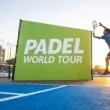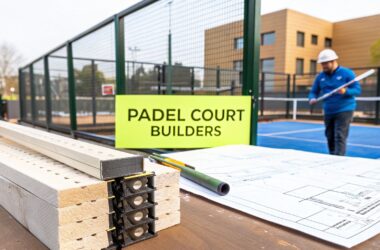If you’ve seen those glass-enclosed courts popping up around town, you’re not alone. You're witnessing the incredible rise of padel, a racket sport that’s taking the world by storm by blending the best parts of tennis and squash into one seriously addictive game.
Some people call it “tennis with walls,” but it’s so much more than that. It’s a fast-paced, strategic, and incredibly social game played in doubles on a compact court. It’s one of the fastest-growing sports on the planet for a reason.
Why Padel Is Taking the World by Storm
The magic of padel is its perfect mix of intensity and accessibility. It combines the thrilling, long rallies you see in tennis with the clever, strategic wall-play of squash.
Think of it like a great board game: the rules are simple enough to pick up in your first session, but the strategic depth will keep you hooked for years. This unique combination makes padel both easy to learn and incredibly difficult to master.

Buy the best padel gear to level up your next game!
CHECK OUT this deal from Padel Market!Get ready to take your game to the next level with the latest padel gear from Padel Market! Fast EU and Worldwide Shipping
A Uniquely Social and Accessible Sport
One of the biggest reasons for padel’s popularity is that it’s social by design. Since it’s always played in doubles on a smaller court (10×20 meters), you’re constantly close to your partner and opponents. This setup encourages non-stop communication, teamwork, and a bit of friendly banter.
The game is also physically accessible. Rallies tend to be longer and less demanding than in tennis, meaning more time hitting the ball and less time chasing it. You don't need a massive, powerful serve to get started; the underhand serve and smaller court make it welcoming for beginners of all ages and fitness levels.
This is why padel is a perfect fit for so many people:
- Families looking for an activity everyone can actually play together.
- Friends who want a fun, competitive social hangout.
- Companies searching for a team-building activity that isn't a trust fall.
The real secret to padel is that it rewards strategy and teamwork over brute force. This levels the playing field, allowing players with different athletic abilities to have a fantastic, competitive match.
The numbers back this up. There are now between 25 to 30 million padel players across more than 110 countries. The sport has a massive female participation rate of nearly 38%, and Google searches for "padel" exploded by 385% in just five years. You can dive deeper into these trends and player demographics in recent studies on padelalto.com.
Before we go further, here's a quick snapshot of what makes padel, padel.
Padel at a Glance
This table breaks down the core elements of the sport for a quick overview.
| Characteristic | Description |
|---|---|
| Players | Always played in doubles (2 vs. 2). |
| The Court | A 10×20 meter rectangle enclosed by glass and mesh walls. The walls are an active part of the game. |
| The Serve | Must be served underhand, after one bounce, at or below waist level. |
| The Ball | Similar to a tennis ball but with slightly less pressure, making it a bit slower and easier to control. |
| The Racket | A solid, stringless "pala" with air holes, smaller and thicker than a tennis racket. |
| The Vibe | Highly social, strategic, and fun. It's often described as less physically demanding than tennis. |
| Scoring | Uses the same scoring system as tennis (15, 30, 40, Deuce, Ad, Game). |
| Core Gameplay | A ball can be played off the walls after it has bounced once on the court, similar to squash. |
As you can see, the game is a unique fusion of concepts from other racket sports, creating something entirely new and exciting.
The Padel Community and Culture
What happens off the court is just as important as what happens on it. Padel clubs have become vibrant social hubs where the post-match drink or meal is part of the ritual. It's this powerful sense of community that keeps people coming back.
You don't just show up for the exercise; you show up for the connection.
This blend of physical activity, mental strategy, and real social interaction is the secret sauce behind the padel craze. It's more than a sport—it’s a lifestyle that builds both fitness and friendships in a fun, supportive environment.
The Unlikely Origins of a Global Sport
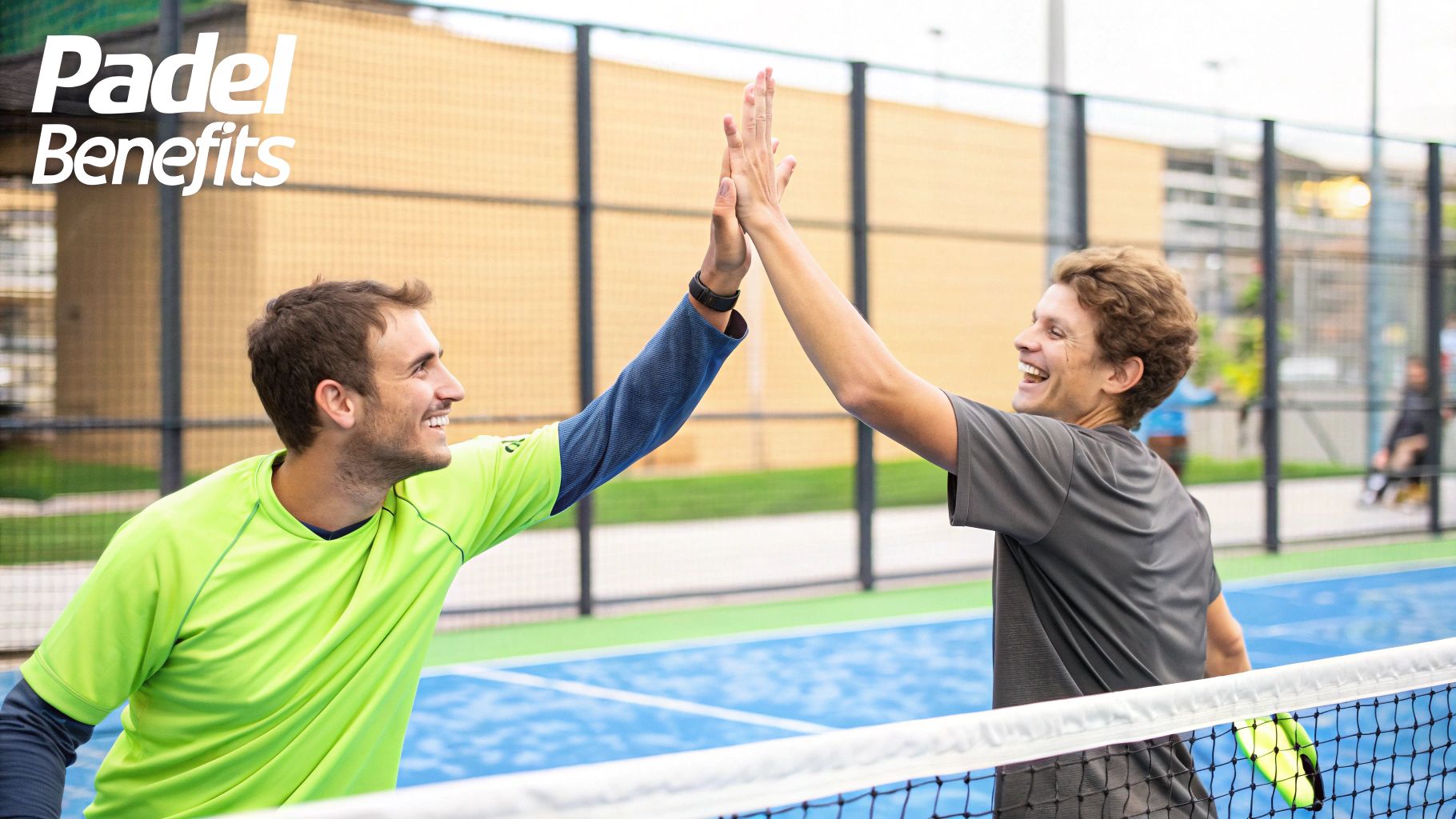
Every great sport has an origin story, but not many are as charming or accidental as padel’s. The journey doesn't start in a high-tech sports lab or a corporate boardroom. Instead, it begins in the sun-drenched resort town of Acapulco, Mexico, way back in 1969.
The man behind it all was a wealthy businessman named Enrique Corcuera. He had a simple goal: to build a squash court at his home. The only problem was, he didn't quite have enough space. Rather than abandoning the idea, he improvised. Corcuera built a smaller court, roughly 10×20 meters, but the real game-changer was born out of a common annoyance. When his tennis balls kept sailing into his neighbor’s yard, he decided to enclose the court with walls up to three meters high.
Without even realizing it, he had just invented a brand-new game. Corcuera and his friends quickly found that letting the ball play off the walls added an incredible new layer of strategy and fun. The game was a bit slower than squash but more tactical and forgiving than tennis. He fittingly called his new creation "Paddle Corcuera."
From Private Court to Global Phenomenon
The sport took its first major leap when one of Corcuera’s friends, the Spanish Prince Alfonso de Hohenlohe, paid him a visit in Acapulco. The prince was instantly hooked. He saw its potential as the perfect, sociable activity for his exclusive Marbella Club Hotel back in Spain.

Buy the best padel gear to level up your next game!
CHECK OUT this deal from Padel Market!Get ready to take your game to the next level with the latest padel gear from Padel Market! Fast EU and Worldwide Shipping
He took the concept home in 1974, tweaking the rules and court design slightly. This single move planted the seeds of padel in Europe, where it quickly became a favorite pastime for the high society of Spain's Costa del Sol.
But Spain wasn't the only country to catch the fever. An Argentinian friend of Hohenlohe's also took the game back to his home country, and there, it absolutely exploded. Unlike its elite beginnings in Spain, padel in Argentina became a sport for the people, spreading like wildfire through local clubs and communities. For decades, Argentina and Spain stood as the two powerhouses of the padel world.
The Modern Padel Explosion
For a long time, padel was mostly a Spanish and Latin American affair. But in the last ten years, its growth has been nothing short of spectacular, transforming it from a regional favorite into a true global sport. The recent expansion has been mind-boggling, pushing far beyond its traditional borders.
This isn't just a feeling; the numbers back it up. The sport is expanding so fast that the infrastructure is racing to keep pace, with new clubs opening at an unbelievable rate.
In just one recent year, a staggering 7,000 new padel courts were built across the globe, bringing the total to over 50,000. This construction boom is tied to a 26% increase in new club openings—that’s like nine brand-new clubs launching every single day. Once heavily concentrated in places like Sweden and Italy, padel is now making serious inroads in countries like Lithuania, Croatia, and the United States, cementing its shift from a niche hobby to a mainstream sport.
This incredible journey from an improvised backyard court to a worldwide sensation is a testament to the game's unique appeal. You can dig deeper into these findings in the 2025 Playtomic report on squashfacilities.com.
Decoding the Court and Essential Gear
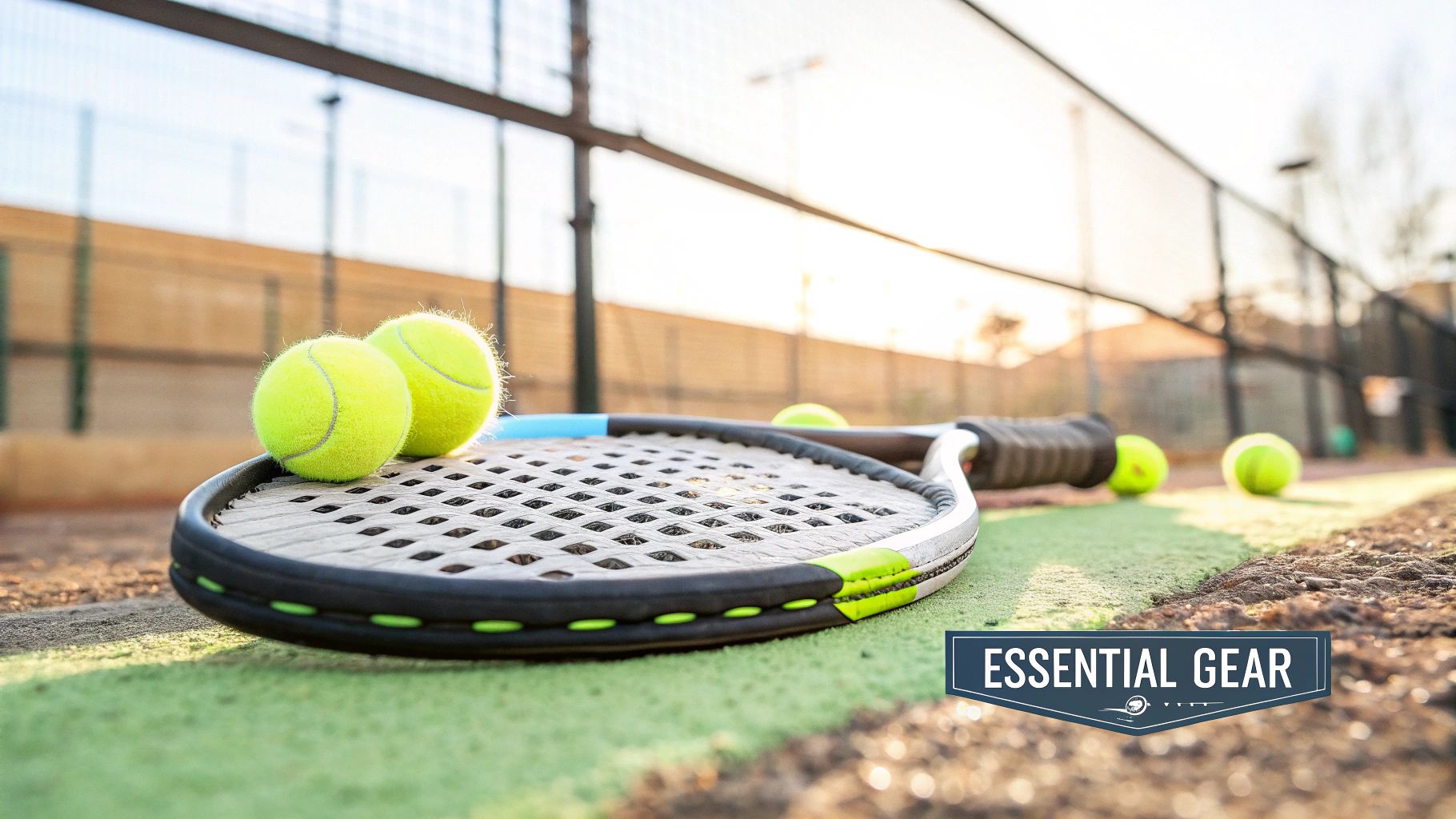
Before you even swing a racket, it’s worth getting to know the unique arena and the essential tools that make padel what it is. The playing environment is really what sets the game apart, turning it into a fast-paced, strategic battle that feels completely different from other racket sports.
A padel court is a 10×20 meter rectangle, enclosed by reinforced glass walls and metallic mesh fencing. It’s a lot smaller than a tennis court, which keeps the action up close and personal and is a huge part of its social vibe.
Don't think of it as a cage, though. Think of it as a strategic box. Those walls aren't just boundaries; they're your best friend. Just like in squash, you can play the ball off the glass, turning what looks like a lost point into a clever offensive shot. Learning how to read the angles off the back and side walls is a core skill that will totally change your game.
Your Padel Gear Checklist
The good news? You don’t need a mountain of expensive equipment to start playing padel. To be game-ready, you just need three key things: a racket, a ball, and the right pair of shoes.
First up is the padel racket, which in Spanish is called a 'pala'. It’s not like a tennis or squash racket with strings. Instead, it has a solid, perforated face made of materials like foam or rubber composites. This unique design gives you fantastic control and a huge sweet spot, making it way more forgiving for newcomers.
Because the racket is so easy to handle, you'll be able to get the hang of hitting the ball and start having fun right away. Rackets come in different shapes—round for maximum control, diamond for more power, and teardrop for a balance of both—but a round racket is the perfect choice for anyone just starting out.
Key Takeaway: The solid, perforated 'pala' is all about control and ease of use. Its forgiving nature helps beginners hold rallies from their very first session, which is a big reason why the sport is exploding in popularity.
Next, you need the right padel balls. They look almost identical to tennis balls, but there’s a crucial difference: they’re slightly smaller and have less internal pressure. This makes them a little less bouncy, slowing the game down just enough to create longer, more tactical rallies and giving you an extra split second to react.
If you try playing with a standard tennis ball, the game will feel way too fast and chaotic, especially with the walls in play. Always stick to official padel balls to get the true feel of the sport. It's this specific pace of play that fueled the massive growth of padel in Barcelona and across Spain.
The Most Important Piece of Gear
Finally, let's talk about what is arguably the most critical item for both your safety and your game: your shoes. Padel is all about sharp, quick movements—pivoting, sudden stops, and lunging side-to-side. The court surface, usually artificial turf covered with a light dusting of sand, demands serious grip.
Wearing your everyday running shoes is a classic rookie mistake that can easily lead to slips, slides, and injuries. Padel-specific shoes are engineered with a few key features to keep you safe and agile:
- A herringbone or omni-court sole designed for perfect traction on the turf.
- Enhanced lateral support to protect your ankles during those quick side-to-side bursts.
- Reinforced materials in high-wear spots to handle the aggressive footwork.
When you're getting your gear together, don't skimp on your footwear. A good pair of non-slip shoes is an investment in your performance and, more importantly, your safety on the court.
How To Play Padel And Master The Rules
So, you're ready to get on the court? The great thing about padel is how quickly you can pick it up and start having a blast, especially if you've ever swung a tennis racket. The game is designed to be intuitive, so you'll be in the middle of exciting rallies before you know it.
Every point kicks off with the serve, a motion that perfectly captures the easy-going spirit of padel. Forget the powerful, intimidating overhead serves you see in tennis. In padel, the serve is strictly underhand.
Here’s how it works: you have to bounce the ball once behind the service line, then hit it at or below your waist. Your goal is to send it diagonally across the net into your opponent's service box. This single rule makes the game so much more accessible for beginners. You can skip the steep learning curve of a tough serve and get right to the fun part—the rally.
If you’re looking to get the serve just right, you can learn more about the complete padel serve rules and what counts as a fault.
Scoring A Padel Match
Once the ball is in play, the scoring will feel very familiar. Padel uses the exact same scoring system as tennis. The points go 15, 30, 40, and then game. If the score hits 40-40, it's called "deuce," and a team needs to win two points in a row to take the game.
To win a set, a team must win six games by a margin of at least two (like 6-4). If the score ties at 6-6, you'll usually play a tie-break to decide the winner. A full match is typically the best of three sets. This classic structure gives new players a solid and familiar framework to start with.
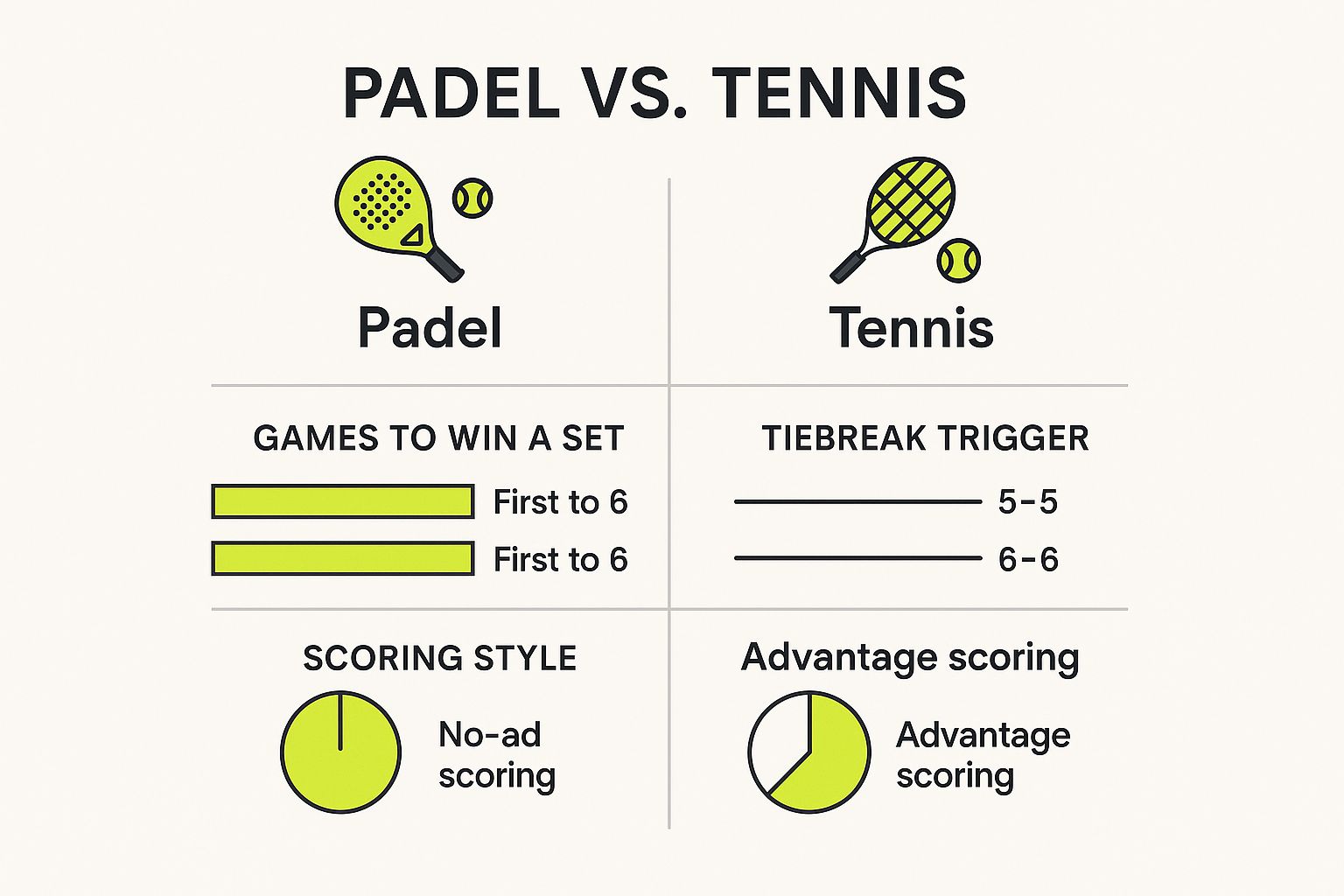
Padel vs Tennis Key Rule Differences
For those coming from a tennis background, a few key rule changes make all the difference. This table breaks down the main distinctions to help you adapt quickly.
| Rule Element | Padel | Tennis |
|---|---|---|
| Serve | Underhand, at or below waist level after one bounce. | Overhand, ball is tossed up and struck overhead. |
| Court | Smaller (10m x 20m), enclosed by glass and mesh walls. | Larger (23.77m x 10.97m), open with no walls in play. |
| Walls | Walls are in play after the ball bounces on the ground. | Walls are out of play; hitting one results in losing the point. |
| Racket | Solid, stringless "pala" with perforations. | Racket with a woven string bed. |
| Doubles | Almost exclusively played in doubles format. | Played in both singles and doubles formats. |
These differences, especially the serve and the use of walls, are what give padel its unique character and strategic depth.
Using The Walls To Your Advantage
Now we get to the most exciting part of padel: the walls. This is where the game's real strategy unfolds, but it's also what can confuse new players the most. Don't worry, the rules are pretty straightforward once you get the main idea.
Think of the walls as an extension of the court, not an obstacle. Your goal is to use them to create better shots, not just to keep the ball in play.
Here's the most important rule for wall play: the ball must bounce on the ground on your opponent's side before it hits any wall or fence. If you hit the ball directly into their wall, you lose the point. It's that simple.
Once the ball has bounced on their side, your opponents have a choice. They can play it before it hits a wall, or they can let it rebound off the glass walls before hitting it back. This is where the magic happens. Instead of scrambling to hit a fast ball, smart players will often step back, let the ball ricochet off the back wall to slow it down, and give themselves more time to line up the perfect return.
Here are the main situations you'll encounter with the walls:
- A Valid Shot: You hit the ball, it bounces on the other side, and your opponent plays it back. They can hit it right after the bounce or after it comes off a glass wall.
- A Fault: You hit the ball so it smacks your opponent's back or side wall before it bounces on the court. That's a point for them.
- Hitting the Fence: The wire mesh fence is also in play. If the ball bounces on the court and then hits the fence, it's still live. But if you hit the fence directly before a bounce, it's a fault.
Learning to use the walls is what will take your game to the next level. It transforms desperate defense into a clever attack and adds a whole new geometric layer to the sport. Once you stop seeing the glass as a barrier and start seeing it as your teammate, you'll unlock the true fun of padel.
Fundamental Shots and Winning Strategies
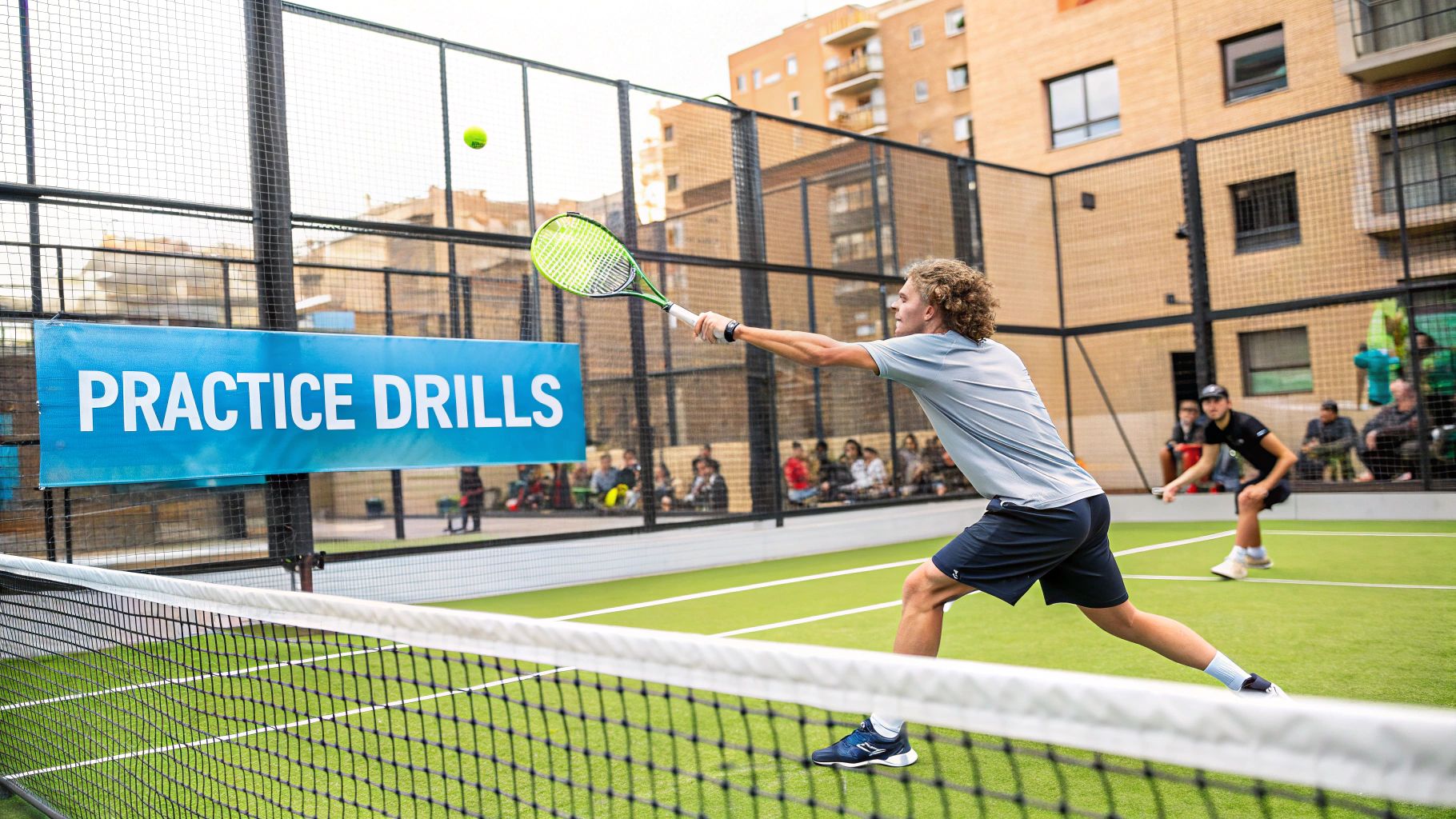
Knowing the rules is one thing, but figuring out how to build a point and outsmart your opponents is what gets you hooked on padel. It's not about who can hit the ball the hardest; it's about hitting the right shot at the right time. Mastering a few key shots will completely change your game, taking you from just getting the ball back to actually controlling the rally.
The real magic of padel is in its strategy. It’s all about teamwork, court position, and picking the perfect shot to exploit your opponent's weaknesses. Let's break down the essential shots that every solid padel player needs in their arsenal.
Mastering The Defensive Overhead: The Bandeja
The bandeja, which means "tray" in Spanish, is arguably the most important shot in the game. It’s a defensive overhead slice you hit not to win the point immediately, but to keep your position at the net and force your opponents to the back of the court.
Picture this: you're at the net, and your opponents lob the ball over your head. Instead of scrambling back to let it bounce, you move backward, turn sideways, and hit the ball with a low, cutting motion. The goal is to send it deep into their corner where it will have a low, tricky bounce, pushing them back and giving you and your partner time to get back to the net.
Think of the bandeja as your reset button. A good one neutralizes an attack and puts the pressure right back on the other team.
Applying Pressure With The Vibora
Meet the vibora, or "viper"—the bandeja's aggressive cousin. While both are overheads you hit on the move, their purpose couldn't be more different. The vibora is all about attack and creating chaos.
Instead of the flat, slicing motion of the bandeja, you hit the side of the ball with heavy spin, almost like a striking snake. This makes the ball skid low and fast off the side wall, making it incredibly unpredictable and tough for your opponents to handle.
You’ll want to unleash the vibora when you get a weaker lob and have a bit more time to set up. It’s the shot that tells your opponents, "I'm not just defending anymore. I'm coming for the point."
An easy way to tell them apart: the bandeja is for defense and depth, while the vibora is for attack and aggression. Getting good at both gives you a versatile overhead game that can handle anything.
Disrupting The Net Game With The Chiquita
While your overheads control the back of the court, the chiquita ("little one") is your secret weapon for breaking up the action at the net. It's a soft, low shot you aim right at your opponents' feet.
When both pairs are fighting for control of the net, smacking the ball hard is often the wrong move. A gentle chiquita forces them to hit an awkward volley up, often popping the ball high enough for you to smash for a winner. It’s a shot that requires touch and precision, not brute force.
Mixing in chiquitas keeps your opponents from getting too comfortable at the net and creates the perfect openings for you and your partner to attack.
Core Doubles Strategy And Teamwork
Padel is a team sport, through and through. You and your partner have to move like a single unit. If you're out of sync, you’ll leave huge gaps on the court that good players will punish every single time.
Here are the basics of padel teamwork:
- Move Together: When your partner pushes up to the net, you go with them. When they drop back, you do too. Imagine you’re tied together with a piece of string—always stay a consistent distance apart.
- Communicate Constantly: Simple calls like "Yours!", "Mine!", or "Out!" are crucial. Clear communication kills confusion and makes sure the player with the better shot takes it.
- Control the Net: The team that controls the net usually controls the point. It's the most powerful position on the court, letting you cut off angles and finish points with volleys and smashes. Your main goal should be to win the net.
To truly get these strategies down, your mental game needs to be as sharp as your physical one. Learning about sports psychology can give you an edge in focus and teamwork. If you're curious, you can find some great sports psychology techniques to help elevate your performance on the court.
Of course, hitting these shots effectively demands a solid physical base. To really put these winning strategies into practice, you need to stay conditioned. Learning how to get stronger will not only add power to your shots but also give you the stamina to last through long, tough matches.
Of course! Here is the rewritten section, crafted to sound completely human-written, following the style and tone of the provided examples.
The Social Heart of the Padel Experience
Sure, mastering the bandeja or executing a perfect strategy feels great, but the real magic of padel often happens after the last point. The sport's true essence is its social culture, which turns a simple game into a genuine community. Honestly, what happens off the court can be just as important as what happens on it.
Unlike sports where you're more isolated, padel is built for connection. The small court and doubles-only format mean you're always close to the other players, which naturally leads to more conversation and teamwork. It’s an environment where friendly trash talk and laughing about a flubbed shot are just as common as a killer rally. Padel clubs aren't just places to play; they become social hubs where grabbing a drink or just chatting after a match is part of the whole ritual.
More Than Just a Game
This social side is a huge reason people get completely hooked. You’re not just booking a court for an hour; you're setting aside time to hang out with friends, meet new people, and feel like you belong to something. The game itself is designed to make this happen.
- Inclusive by Nature: One of the best things about padel is that players of different ages, fitness levels, and skills can all share a court and have a blast. Everyone can play together and still have a competitive, fun match.
- Teamwork Focused: You can't win alone. Success in padel is all about your partnership, demanding constant communication and moving in sync with your teammate.
- A Shared Experience: That amazing feeling of winning a long, hard-fought rally or pulling off a tricky shot? It's a moment shared and celebrated by all four players on the court.
Padel is celebrated as much for the friendships it builds as for the fitness it provides. It’s one of those rare activities that perfectly blends a good workout, mental strategy, and real social fun into one package.
A Sustainable and Healthy Lifestyle
Beyond making new friends, padel offers a fantastic mix of physical and mental health perks. It’s a great cardio workout that gets your heart rate up and builds stamina. The constant movement, quick turns, and reactive shots keep you on your toes and active for the entire match.
But one of its biggest health benefits is how easy it is on your body. Compared to high-impact sports like tennis or running, padel is much kinder to your joints, especially your knees and ankles. The court is smaller, so you’re not doing long, punishing sprints, and using the walls lets you move in a more controlled, strategic way. This makes padel a sport you can stick with for decades, helping you stay active and social well into your later years.
Your Top Padel Questions, Answered
Getting ready to jump into the world of padel? It's completely normal to have a few questions floating around. While the sport is surprisingly easy to get into, knowing the answers to a few common queries can make your first time on the court that much smoother.
Let’s clear up some of the top questions we hear from new players.
Do I Need a Partner to Start Playing Padel?
Padel is a doubles game, which means you'll need three other people for a full match. But—and this is a big but—you absolutely don't need to show up with a pre-arranged group to get started. This is one of the best things about the padel community.
Most clubs and booking apps have built-in systems to help you find a game. You can easily join "open matches," where the club or app matches you with other players around your skill level. It's a fantastic way to meet new people and get playing right away, even if you’re flying solo.
Is Padel Hard for Beginners to Learn?
Not at all! In fact, padel is famous for being one of the easiest racket sports for a newcomer to pick up and enjoy. The court is smaller, the underhand serve is simple to master, and the solid racket is much more forgiving than a traditional stringed one.
The biggest hurdle in most racket sports is just getting a rally going. In padel, most beginners are having fun and hitting proper rallies within their first hour on the court. That instant gratification is a huge reason for its incredible growth.
What's the Biggest Mistake New Padel Players Make?
The most common rookie mistake is seeing the glass walls as an obstacle instead of an ally. When you're new, your first instinct is to panic and hit the ball before it can touch the back wall.
A core part of padel strategy is to actually let the ball hit the back glass. This simple move slows the ball down, gives you way more time to get into the perfect position, and sets you up for a much more controlled and powerful return. Learning to use the walls is the first major step from just playing padel to truly understanding it.
At Padel Rumors, we're passionate about helping you through every stage of your padel journey. For more in-depth guides, honest gear reviews, and the latest news from the pro tours, be sure to visit us at https://www.padelrumors.com.







